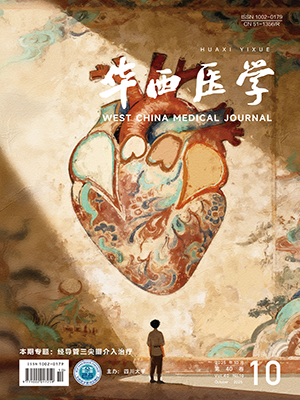| 1. |
全国儿科哮喘协作组, 中国疾病预防控制中心环境与健康相关产品安全所. 第三次中国城市儿童哮喘流行病学调查. 中华儿科杂志, 2013, 51(10): 729-735.
|
| 2. |
Li X, Song P, Zhu Y, et al. The disease burden of childhood asthma in China: a systematic review and meta-analysis. J Glob Health, 2020, 10(1): 010801.
|
| 3. |
Lang A, Carlsen KH, Haaland G, et al. Severe asthma in childhood: assessed in 10 year olds in a birth cohort study. Allergy, 2008, 63(8): 1054-1060.
|
| 4. |
Smith DH, Malone DC, Lawson KA, et al. A national estimate of the economic costs of asthma. Am J Respir Crit Care Med, 1997, 156 (3 Pt 1): 787-793.
|
| 5. |
Pijnenburg MW, Fleming L. Advances in understanding and reducing the burden of severe asthma in children. Lancet Respir Med, 2020, 8(10): 1032-1044.
|
| 6. |
Stefanowicz D, Hackett TL, Garmaroudi FS, et al. DNA methylation profiles of airway epithelial cells and PBMCs from healthy, atopic and asthmatic children. PLoS One, 2012, 7(9): e44213.
|
| 7. |
Orsmark-Pietras C, James A, Konradsen JR, et al. Transcriptome analysis reveals upregulation of bitter taste receptors in severe asthmatics. Eur Respir J, 2013, 42(1): 65-78.
|
| 8. |
Barrett T, Wilhite SE, Ledoux P, et al. NCBI GEO: archive for functional genomics data sets-update. Nucleic Acids Res, 2013, 41(Database issue): D991-D995.
|
| 9. |
Ritchie ME, Phipson B, Wu D, et al. limma powers differential expression analyses for RNA-sequencing and microarray studies. Nucleic Acids Res, 2015, 43(7): e47.
|
| 10. |
Walter W, Sánchez-Cabo F, Ricote M. GOplot: an R package for visually combining expression data with functional analysis. Bioinformatics, 2015, 31(17): 2912-2914.
|
| 11. |
Futschik ME, Carlisle B. Noise-robust soft clustering of gene expression time-course data. J Bioinform Comput Biol, 2005, 3(4): 965-988.
|
| 12. |
Langfelder P, Horvath S. WGCNA: an R package for weighted correlation network analysis. BMC Bioinformatics, 2008, 9: 559.
|
| 13. |
中华儿科杂志编辑委员会, 中华医学会儿科学分会呼吸学组, 中国医师协会儿科医师分会儿童呼吸专业委员会. 儿童支气管哮喘规范化诊治建议(2020 年版). 中华儿科杂志, 2020, 58(9): 708-717.
|
| 14. |
李丹, 范宇杭, 李耕旭, 等. GNA15 对重型哮喘患儿预后的预测价值. 实用医学杂志, 2022, 38(6): 758-762.
|
| 15. |
Offermanns S, Simon MI. G alpha 15 and G alpha 16 couple a wide variety of receptors to phospholipase C. J Biol Chem, 1995, 270(25): 15175-15180.
|
| 16. |
Davignon I, Catalina MD, Smith D, et al. Normal hematopoiesis and inflammatory responses despite discrete signaling defects in Galpha15 knockout mice. Mol Cell Biol, 2000, 20(3): 797-804.
|
| 17. |
van den Bos E, Ambrosy B, Horsthemke M, et al. Knockout mouse models reveal the contributions of G protein subunits to complement C5a receptor-mediated chemotaxis. J Biol Chem, 2020, 295(22): 7726-7742.
|
| 18. |
Denlinger LC, Phillips BR, Ramratnam S, et al. Inflammatory and comorbid features of patients with severe asthma and frequent exacerbations. Am J Respir Crit Care Med, 2017, 195(3): 302-313.
|
| 19. |
Levine SJ, Wenzel SE. Narrative review: the role of Th2 immune pathway modulation in the treatment of severe asthma and its phenotypes. Ann Intern Med, 2010, 16,152(4): 232-237.
|
| 20. |
Khalfaoui L, Symon FA, Couillard S, et al. Airway remodelling rather than cellular infiltration characterizes both type2 cytokine biomarker-high and -low severe asthma. Allergy, 2022, 77(10): 2974-2986.
|
| 21. |
Ross KR, Gupta R, DeBoer MD, et al. Severe asthma during childhood and adolescence: a longitudinal study. J Allergy Clin Immunol, 2020, 145(1): 140-146.e9.
|
| 22. |
Benson VS, Hartl S, Barnes N, et al. Blood eosinophil counts in the general population and airways disease: a comprehensive review and meta-analysis. Eur Respir J, 2022, 59(1): 2004590.
|
| 23. |
Yancey SW, Keene ON, Albers FC, et al. Biomarkers for severe eosinophilic asthma. J Allergy Clin Immunol, 2017, 140(6): 1509-1518.
|
| 24. |
FitzGerald JM, Bleecker ER, Menzies-Gow A, et al. Predictors of enhanced response with benralizumab for patients with severe asthma: pooled analysis of the SIROCCO and CALIMA studies. Lancet Respir Med, 2018, 6(1): 51-64.
|
| 25. |
Bacharier LB, Maspero JF, Katelaris CH, et al. Dupilumab in children with uncontrolled moderate-to-severe asthma. N Engl J Med, 2021, 385(24): 2230-2240.
|
| 26. |
Wechsler ME, Ford LB, Maspero JF, et al. Long-term safety and efficacy of dupilumab in patients with moderate-to-severe asthma (TRAVERSE): an open-label extension study. Lancet Respir Med, 2022, 10(1): 11-25.
|




